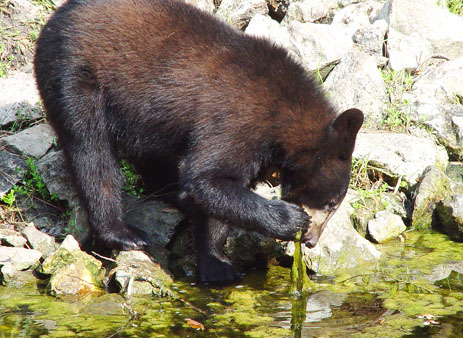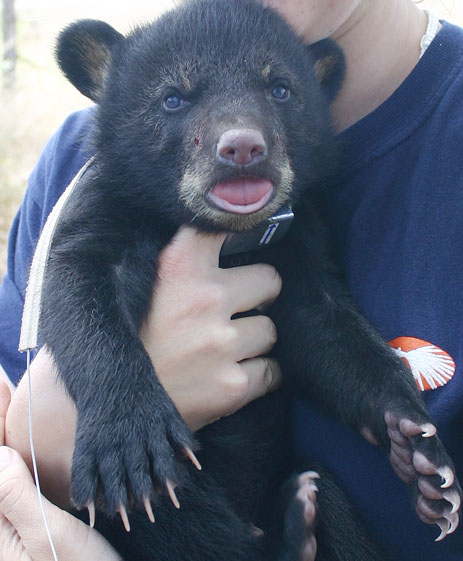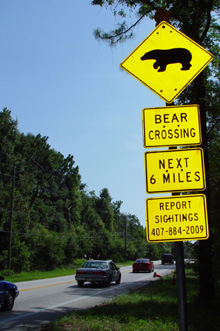 |
|||||||||||
|
|||||||||||
|
Ursus americanus Photo Fiona Sunquist © When it comes to wildlife, the black bear is the largest land mammal you are likely to see in Florida. The only thing bigger is the aquatic manatee. Florida black bears are not huge; female bears average about 180 lbs (82kg) and males 249 lbs (113 kg). However a few males grow considerably larger - in 1990, a male killed by a car in south Florida weighed in at 627 lb! Florida bears are usually completely black with a brown muzzle and occasionally a light colored chest patch. Bears in south Florida sometimes loose the long black guard hairs and become woolly brown. Black bears use a wide range of forested lands, and feed in different habitats at different seasons as foods become available. In early spring they feed on emerging green vegetation. During summer they concentrate on fruits of the saw palmetto, swamp tupelo, cabbage palm, blueberry, grapes and sweet gallberry. Black gum fruits, and nuts and acorns become important during fall, and insects, honey, small animals, and carrion supplement their diet year round. Except for females and their cubs, bears are solitary animals. Adults often have overlapping home ranges, but they rarely travel or feed together except in the mating season. Radio-collared bears in Osceola and Ocala National forests have relatively large home ranges – females travel over about 28 sq km (11 sq miles) and male ranges average 170 sq km (66 sq miles). In northern states, both male and female bears hibernate for several months and females give birth during hibernation. In Florida, adult males, non-pregnant females and young adults often remain active throughout the year or den only for a short time. Pregnant females are the exception - they always hibernate, even in places like Florida where winter temperatures remain warm and food is plentiful. Scientists have no completely satisfactory explanation for why females should need to hibernate under these conditions, but they believe that for bears there must be a deep evolutionary link between the reproductive process and hibernation. In Florida, female black bears give birth in January or February to a litter of two or three cubs. When the cubs are about two months old they begin to travel with their mother; however they continue to nurse until fall and the family does not split up until the cubs are about 16 months old. This long period of maternal investment means that females only breed every other year. About half of all cubs die during the first year of life.
Photo Fiona Sunquist © Studies of radio-collared bears show that when it comes to parenting, experience matters. Cubs born to mothers who had previously had young were twice as likely to survive. Cannibalism by resident males was the most important mortality factor for cubs. Between 1978 and 2001 there were 4,389 reports of human/bear conflicts reported in Florida. Almost half of these reports were of a bear in the yard. The second most frequent complaint was of bears in garbage cans. The current policy of the Florida Fish and Wildlife Conservation Commission towards ‘nuisance’ bears is to first try removing the attractants, or preventing access by bears, or installation of an electric fence. Second-time offenders are trapped, tattooed, ear tagged and relocated. Third-time offenders may be euthanized. Recent estimates put Florida’s bear numbers at somewhere between 1500 and 3000. Collisions with vehicles are the leading cause of bear mortality. In 2007, 142 bears were killed on Florida's roads. Authorities are attempting to reduce the number of bears killed by cars by putting up bear crossing signs at sites where bears frequently cross roads, and including wildlife underpasses in new highway construction projects.
Photo Fiona Sunquist © You are most likely to see bears in 5 major public areas in Florida: Ocala National Forest, Osceola National Forest-Okefenokee Swamp, Apalachicola National Forest, Big Cypress National Preserve, and Eglin Air Force Base. Small populations of 20-40 bears occur in the Chassahowitzka NWR and the Highland/Glades county area.
|
| • Live weather radar • About Florida weather • Map & Key to Regions |

Wildlife of Florida 2011
Fiona Sunquist
Download $19.99


Wildlife of Florida: Lizards
Fiona Sunquist
Download $2.49

gator/crocs | birds | mammals | snakes | turtles | frogs/toads | lizards | sharks
Wildlife | Favorite Activities | My Destinations | about us | resources | site map | home
![]() web site development by Creative Communications
web site development by Creative Communications














